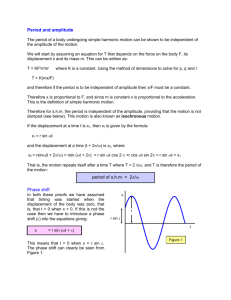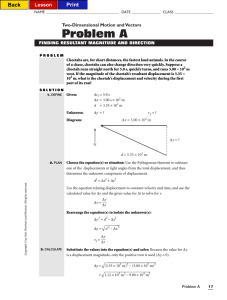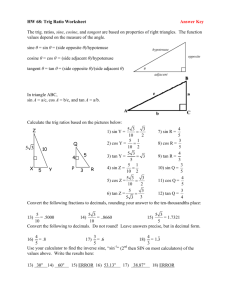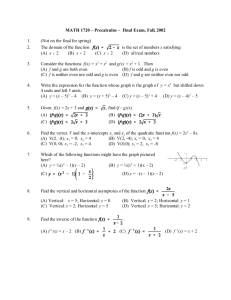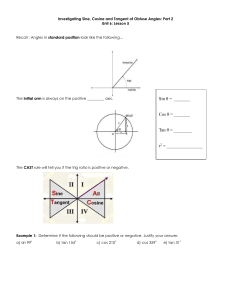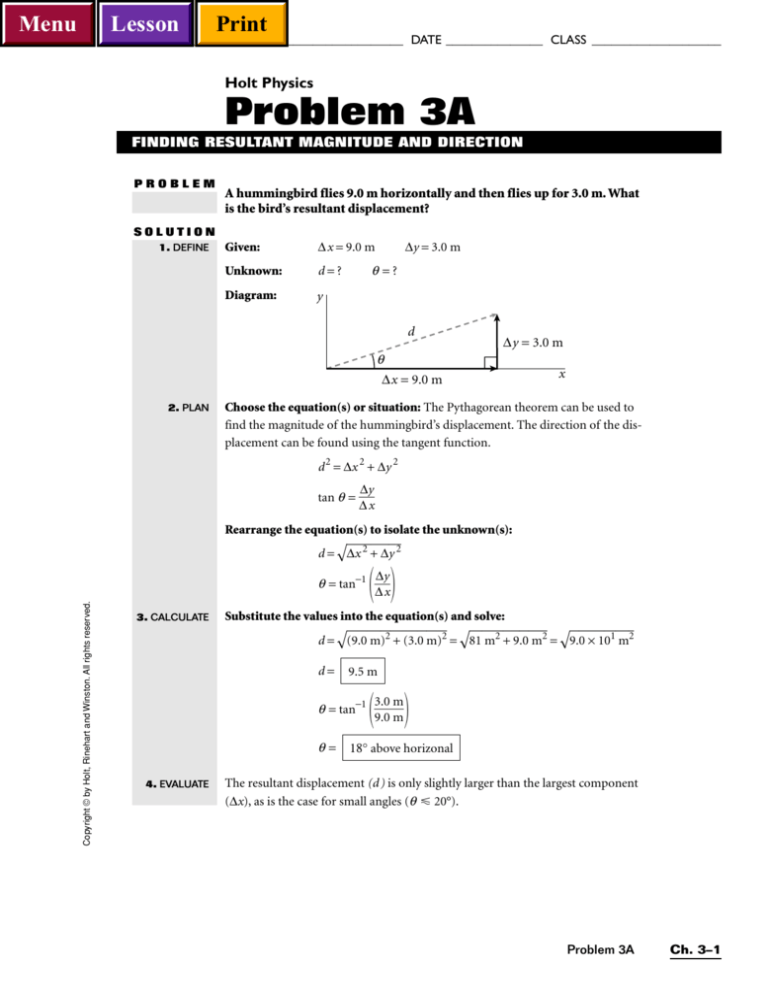
Menu
Lesson
Print
NAME ______________________________________ DATE _______________ CLASS ____________________
Holt Physics
Problem 3A
FINDING RESULTANT MAGNITUDE AND DIRECTION
PROBLEM
A hummingbird flies 9.0 m horizontally and then flies up for 3.0 m. What
is the bird’s resultant displacement?
SOLUTION
1. DEFINE
Given:
∆x = 9.0 m
Unknown:
d=?
Diagram:
y
∆y = 3.0 m
q =?
d
∆y = 3.0 m
θ
∆x = 9.0 m
2. PLAN
x
Choose the equation(s) or situation: The Pythagorean theorem can be used to
find the magnitude of the hummingbird’s displacement. The direction of the displacement can be found using the tangent function.
d 2 = ∆x 2 + ∆y 2
∆y
tan q = ∆x
Rearrange the equation(s) to isolate the unknown(s):
d= ∆
∆y2
x2+
Copyright © by Holt, Rinehart and Winston. All rights reserved.
∆y
q = tan−1 ∆x
3. CALCULATE
Substitute the values into the equation(s) and solve:
d = (9
m)2
+(3.
)2 = 81
m2+
m2 = 9.
0×
01
m2
.0
0m
9.0
1
d=
9.5 m
3.0 m
q = tan−1 9.0 m
q=
4. EVALUATE
18° above horizonal
The resultant displacement (d) is only slightly larger than the largest component
(∆x), as is the case for small angles (q 20°).
Problem 3A
Ch. 3–1
Menu
Lesson
Print
NAME ______________________________________ DATE _______________ CLASS ____________________
ADDITIONAL PRACTICE
1.
A tiger paces back and forth along the front of its cage, which is 8 m
wide. The tiger starts from the right side of the cage, paces to the left
side, then back to the right side, and finally back to the left.
a. What total distance has the tiger paced?
b. What is the tiger’s resultant displacement?
2. A particular type of rubber ball is able to bounce to 0.90 times the height
from which it is dropped. The ball is dropped from a height of 0.91 m,
but it falls slightly away from the vertical, so that by the time it has
bounced to its new height it has undergone a horizontal displacement of
0.11 m. What is the ball’s resultant displacement from its initial height to
its maximum height after one bounce?
3. A helicopter flies 165 m horizontally and then moves downward to land
45 m below. What is the helicopter’s resultant displacement?
4. A toy parachute is dropped from an open window that is 13.0 m above
the ground. If the parachute travels 9.0 m horizontally, what is the resultant displacement?
6. An airplane taxis to the end of a runway before taking off. The magnitude of the plane’s total displacement is 599 m. If the northern component of this displacement is 89 m, what is the displacement’s eastern
component? What is the direction of the total displacement?
7. The straightest stretch of railroad tracks in the world extends for 478 km
in southwestern Australia. A train traveling along these tracks is displaced to the south by about 42 km. What is the train’s displacement to
the west? What is the direction of the total displacement?
8.
Ch. 3–2
Before the widespread use of steamships, sailing from Europe to North
America was accomplished by use of the “trade winds.” The trade winds
move from the northeast to the southwest between 30° and 60° latitude
in the northern hemisphere. A ship sailing from Europe to the Caribbean
Sea would first travel southward to the Canary Islands, off the coast of
North Africa, and then use the trade winds to sail west. Suppose a ship
travels south from Iceland to the Canary Islands, and then west to
Florida. The ship’s total displacement is 7400 km at 26° south of west. If
the ship sails 3200 km south from Iceland to the Canary Islands, how
large is the western component of its journey?
Holt Physics Problem Bank
Copyright © by Holt, Rinehart and Winston. All rights reserved.
5. An octopus swims 36.0 m east, 42.0 m north, and then rises 17.0 m toward the surface of the water. What is the octopus’s displacement?
(TWO-DIMENSIONAL METHOD: Visualize a horizontal and a vertical
triangle. Find the horizontal resultant; use that with the vertical distance
to calculate the final resultant. Studying this method can lead to understanding the easier three-dimensional solution in the solutions manual.)
Menu
Lesson
Print
NAME ______________________________________ DATE _______________ CLASS ____________________
9.
The Palm Springs Aerial Tramway extends 3.88 km from the Valley Station, which is located 0.8 km above sea level, to the Mountain Station
atop San Jacinto Peak. The actual path of the tramway’s cables is not
along a straight line, but if it were, the horizontal displacement of the
tramway would be 3.45 km. How far is San Jacinto Peak above sea
level?
Copyright © by Holt, Rinehart and Winston. All rights reserved.
10. The islands that form the Tristan da Cunha Group in the South Atlantic Ocean are considered to be the most remote places in the world:
the next nearest inhabited island is 2400 km away. If you sail from
Capetown, South Africa, in a south by southwest direction, you must
travel 2.9 × 103 km before reaching the Tristan da Cunha islands. If the
western component of your displacement is 2.8 × 103 km, what is your
displacement south? In what direction is the resultant displacement?
Problem 3A
Ch. 3–3
Menu
Lesson
Print
Two -Dimensional Motion and Vectors
Chapter
3
Additional Practice 3A
Givens
1. ∆x1 = 8 m to the left = +8 m
∆x2 = 8 m to the right
= −8 m
Solutions
a. distance traveled = 8 m + 8 m + 8 m = 24 m
b. d = ∆x1 + ∆x2 + ∆x3 = 8 m + (−8 m) + 8 m = 8 m
∆x3 = 8 m to the left = +8 m
2. hi = 0.91 m
∆y = hf − hi = (0.90 − 1.00)hi
hf = (0.90)hi
∆y = (−0.10)(0.91 m) = −9.1 × 10−2 m
∆x = 0.11 m
d= ∆
∆y2 = (0
)2
+(−
)2 = 1.
0−2m
0−3m
x2+
.1
1m
9.
1×10−2m
2×1
2+8.3
×1
2
d = 2.0 × 10−2 m2 = 0.14 m
∆y
−9.1 × 10−2 m
q = tan−1 = tan−1
∆x
0.11 m
q = −4.0 × 101° = 4.0 × 101° below the horizontal
3. ∆x = 165 m
∆y = −45 m
d= ∆
∆y2 = (1
m
)2
+(−
m
)2 2.
04
m2+
03
m2 = 2.
04
m2
x2+
65
45
72
×1
2.0
×1
92
×1
d = 171 m
∆y
−45 m
q tan−1 = tan−1
∆x
165 m
Copyright © by Holt, Rinehart and Winston. All rights reserved.
q = −15° = 15° below the horizontal
4. ∆y = −13.0 m
∆x = 9.0 m
d= ∆
∆y2 = (9
m
)2
+(−
m
)2 = 81
m2+
m2 = 2.
02
m2
x2+
.0
13
.0
169
50
×1
d = 15.8 m
∆y
−13.0 m
q = tan−1 tan−1
∆x
9.0 m
q = −55° = 55° below the horizontal
5. ∆x = 36.0 m, east
∆y = 42.0 m, north
∆z = 17.0 m, up
d= ∆
∆y2+
∆
z 2 = (3
)2
+(42
m
)2
+(17
m
)2
x2+
6.
0m
.0
.0
d = 1.
03
m2+
03
m2+
m2 = 3.
03
m2
30
×1
1.7
6×1
289
35
×1
d = 57.9 m
∆y
42.0 m
horizontal direction = qh = tan−1 = tan−1
∆x
36.0 m
qh = 49.4° north of east
∆z
vertical direction = qv = tan−1
∆x 2 + ∆y 2
Section Five—Problem Bank
V
V Ch. 3–1
Menu
Lesson
Print
Givens
Solutions
17.0 m
3.
0
m
06
×1
17.0 m
17.0 m
= tan−1
qv = tan−1 3 2
2
2
1.
0
m+
03
m2
(3
6.
0
m
)
+(
42
.0
m
)
30
×1
1.7
6×1
= tan−1
3
2
qv = 17.1° above the horizontal
6. d = 599 m
d 2 = ∆x 2 + ∆y 2
∆y = 89 m north
∆x = d2−
∆y2 = (5
m)2
−(89
m)2 = 3.
m2−
m2
99
59
×105
7.9
×103
∆x = 3.
05
m2
51
×1
∆x = 592 m, east
∆y
89 m
q = sin−1 = sin−1
d
599 m
q = 8.5 ° north of east
7. d = 478 km
∆y = 42 km, south = −42 km
d 2 = ∆x 2 + ∆y 2
∆x = d 2−
∆
y 2 = (4
)2
−(−
)2 2.
05km
03km
78
km
42
km
28
×1
2−1.8
×1
2
∆x = 2.
05km
26
×1
2 = −475 km
∆x = 475 km, west
∆y
−42 km
q = sin−1 = sin−1
d
478 km
q = 5.0° south of west
q = 26° south of west
∆y = 3200 km, south =
−3200 km
d2 = ∆x 2 = ∆y 2
∆x = d 2−
∆
y 2 = (7
)2
−(−
)2 = 5.
07km
07km
40
0km
32
00
km
5×1
2−1.0
×1
2
∆x = 4.
07km
5×1
2 = −6700 km
∆x = 6700 km, west
9. d = 3.88 km
∆x = 3.45 km
h1 = 0.8 km
d 2 = ∆x 2 + ∆y 2
∆y = 1.8 km
height of mountain = h = ∆y + h1 = 1.8 km + 0.8 km
h = 2.6 km
V
V Ch. 3–2
∆y = d2−
∆x2 = (3
.8
8km
)2−(3.
45
km
)2 = 15
.1
km
2−11.
9km
2 = 3.
2km
2
Holt Physics Solution Manual
Copyright © by Holt, Rinehart and Winston. All rights reserved.
8. d = 7400 km
Menu
Lesson
Print
Givens
10. d = 2.9 × 103 km
∆x = 2.8 × 103 km, west
= −2.8 × 103 km
Solutions
d 2 = ∆x 2 + ∆y 2
∆y = d 2−
∆x2 = (2
03km
)2
−(−
03
)2
.9
×1
2.
8×1
∆y = 8.
06km
06km
06km
4×1
2−7.8
×1
2 = 0.
6×1
2 = −800 km
∆y = 800 km, south
∆x
−2.8 × 103 km
q = cos−1 = cos−1
d
2.9 × 103 km
q = 15° south of west
Additional Practice 3B
1. d = 5.3 km
q = 8.4° above horizontal
∆y = d(sin q) = (5.3 km)(sin 8.4°)
∆y = 0.77 km = 770 m
the mountain’s height = 770 m
2. d = 19.1 m
q = 3.0° to the left
∆y = d(sin q) = (19.1 m)(sin 3.0°)
∆y = 1.0 m to the left
the lane’s width = 1.0 m
3. d = 113 m
q = 82.4° above the
horizontal south
4. v = 55 km/h
q = 37° below the horizontal
= −37°
Copyright © by Holt, Rinehart and Winston. All rights reserved.
5. d = 2.7 m
q = 13° from the table’s
length
∆x = d(cos q) = (113 m)(cos 82.4°)
∆x = 14.9 m, south
vy = v(sin q) = (55 km/h)[sin(−37°)]
vy = −33 km/h = 33 km/h, downward
∆x = d(cos q) = (2.7 m)(cos 13°)
∆x = 2.6 m along the table’s length
∆y = d(sin q) = (2.7 m)(sin 13°)
∆y = 0.61 m along the table’s width
6. v = 1.20 m/s
q = 14.0° east of north
vx = v(sin q) = (1.20 m/s)(sin 14.0°)
vx = 0.290 m/s, east
vy = v(cos q) = (1.20 m/s)(cos 14.0°)
vy = 1.16 m/s, north
7. d = 31.2 km
q = 30.0° west of south
∆x = d (sin q) = (31.2 km)(sin 30.0°)
∆x = 15.6 km, west
∆y = d (cos q) = (31.2 km)(cos 30.0°)
∆y = 27.0 km, south
V
Section Five—Problem Bank
V Ch. 3–3


